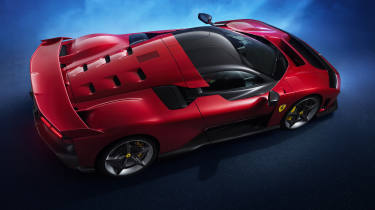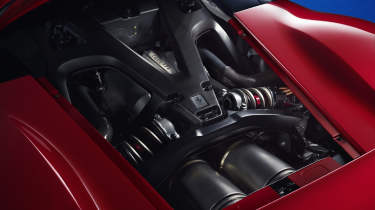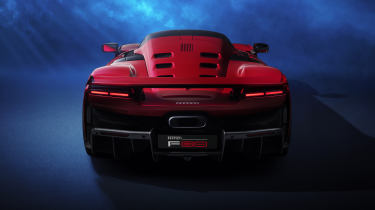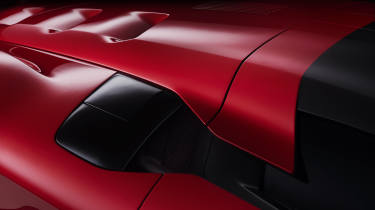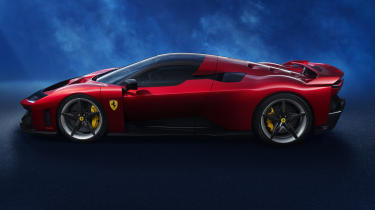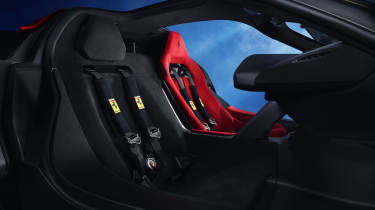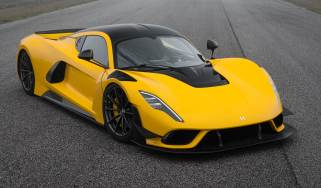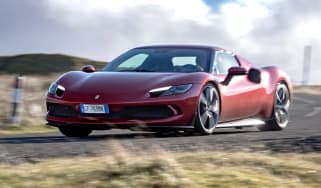New Ferrari F80 hypercar: £3.1m LaFerrari successor with 1184bhp V6 hybrid
Inspired by motorsport and with the highest output of any road-going Ferrari, Maranello’s new F80 flagship tackles the McLaren W1 head-on. Watch the video...
It’s been over a decade since the LaFerrari made its first appearance in 2013, setting new standards with its hybrid V12 powertrain. Now, with McLaren’s W1 hot off the press, Ferrari has uncovered the F80. An answer to Woking’s new hypercar and a distillation of the best Maranello has to offer, just 799 examples will be sold at c£3.1m apiece.
Launched 40 years since the first model in the line, the 288 GTO, the F80’s name celebrates Ferrari’s upcoming 80th year. Lifting elements from Le Mans and Formula 1, it’s the firm’s quickest and most complex road-going model to date, but that certainly hasn’t deterred customers, with each and every car already sold.
> The £2m McLaren W1 is a 1257bhp successor to the P1
Powertrain
While the launch of the 12 Cilindri suggested Ferrari would treasure its iconic V12 for as long as it possibly could, the pinnacle of its range now goes without it. The F80 utilises a V6 with the same basic block as the double Le Mans-winning 499P racer (and 296 GTB), paired with a self-charging hybrid system. Despite six fewer cylinders and under half the displacement of its predecessor, it produces 234bhp more in total, 1184bhp on tap.
What’s most impressive is that the new 9200rpm V6 is responsible for 888bhp of this total (at 8750rpm), with a 3-litre capacity giving it an incredible 296bhp per-litre specific output. Numerous internal upgrades have helped liberate this extra power, with use of titanium bolts and a revised crankcase allowing it to retain the same weight figure as the unit in the 296 GTB.
Sound will be a subject on the minds of many, as while the V6’s performance might be impressive, a six cylinder will never have quite the same exotic edge as the V12 that came before it. We’ll have to wait for our first drive for a definitive verdict, but based on a brief sound clip, the combination of Inconel manifolds and its unique 1-6-3-4-2-5 firing order make for an incredibly convincing sound in place of a Ferrari V12.
Unlike the rear-drive McLaren W1, the F80 sends this power to all four wheels, making it the first all-wheel drive Ferrari flagship and one capable of a ludicrous 2.15sec 0-62mph time, over five tenths quicker than its British rival. Top speed is suitably flagship too at ‘over’ 217mph, matching both the LaFerrari and new McLaren W1.
Many manufacturers claim their products take inspiration from the track, but with both MGU-K and MGU-H systems to recover energy from the electric motors and new, enlarged electrically assisted turbochargers, the F80 takes this to the next level. At the core of the system is a single 8.8kg, 30,000rpm electric motor for the MGU-K, acting as a starter motor, power generator and delivering an 80bhp boost to the rear axle. Combine this with a dual-motor electric front axle, now developed in house with an improved output and 36kg drop in weight over the SF90’s (61.5kg in total), the hybrid system contributes 292bhp to the final power figure.
Much of the hybrid system’s impressive performance comes from the use of an 800V architecture and a new lightweight, in-house developed battery that takes its chemistry from Formula 1. Unlike the recent 296 GTB and SF90 Stradale, though, the F80 isn’t a plug-in hybrid and can’t run in pure-electric mode, with its electric assistance purely to boost performance. The choice to forego a plug-in system is also said to improve useability while keeping weight to a minimum.
An interesting side note is that given it now produces the batteries in-house, Ferrari has already applied this new battery technology to the LaFerrari, developing a unit to be retrofitted to the model for longevity. Given the boost in power density, battery weight is lower than before and Ferrari even claims it will offer more power. Buyers of the F80 (and all hybrid Ferrari models) will now be able to purchase an eight year extended warranty that will include the replacement of the battery, making cell degradation much less of a concern than before.
Chassis and aero
The F80 comes in at a quoted 1525kg dry, 270kg more than the LaFerrari, with distribution 43:57 front to rear. While more weight is rarely good, this is still an impressive effort given the increase in performance and complexity, with Ferrari going further than ever to keep that figure low. A new asymmetrical carbonfibre tub, aluminium subframes and titanium screws all help keep weight down, with stunning in-house printed titanium wishbones used to mount its active Multimatic suspension.
It doesn’t take an engineer to determine that aerodynamics are a high priority, with its lower aero elements and towering active rear wing somewhat of a giveaway. The results prove it’s not just for show, with Ferrari claiming peak downforce of 1050kg at 155mph, 190kg more than the 992 GT3 RS at its peak.
This downforce number comes from a variety of aero devices, including some incredible underbody aero, a 1.5m deep diffuser section, NACA ducts aft of the doors (which also increase output by 5bhp via the ram effect) and a huge S-duct at the front. Even the tub itself was designed with aero in mind, with raised footwells making space for underbody vortex-generating bargeboards. That rear wing also contributes a good amount, producing 180kg of downforce at 155mph when at its maximum 11 degree angle of attack. Even the active suspension boosts downforce, helping to create ground effect under the right conditions.
Design
Lower, wider and longer than the LaFerrari it replaces, the F80 has undeniable presence. Finished in a new Rosso Supercar shade, it’s carbonfibre bodywork evokes elements of the SP3 Daytona, 12 Cilindri and even icons of the past such as the F40. Its aesthetic is far from as elegant and clean as its predecessor, but a blend of function and form give it some real purpose.
The 12 Cilindri’s distinctive front visor has been carried across to the F80, designed to disguise the headlights and create a ‘space age’ look – even this features a subtle gurney flap for aero benefits. The large S-duct opening is front and centre ahead of the windscreen, and if you move your eyes down to just below its SP3-esque nose, you’ll see a pair of nostril-like openings. These aren’t sensor housings for driver assistance systems, but instead openings to direct air directly into the hollow tubes of the front crash structure, which is then fed to the front 408mm CCM-R brakes (now constructed from a longer-lasting carbon ceramic compound) for cooling.
Designer Flavio Manzoni, also responsible for the LaFerrari, said he began the design process with a single-seater concept, added two seats and worked from there. The result is a compact teardrop cockpit (50mm lower than the LaFerrari’s), leaving room for imposing rear haunches to create its dramatic presence. While Manzoni did say the F80 is ‘...not nostalgic at all, but very futuristic,’ it features numerous references to models of the past. The flat panel aft of the front wheel harks back to the F40, with the central oval tailpipe doing the same. The rear engine cover vents also reference historic models, but this time feature six vents to match its cylinder count.
There are clear similarities to the SP3 Daytona from the rear ¾ view, with its short tail, bulging haunches and expansive rear deck also seen here. The F80 is significantly more technical everywhere you look, though, with huge NACA ducts sliced into the bodywork to leave elements overhanging the side windows, positioned ahead of the rear arches from the top down. The technicality continues with the 20 and 21-inch (front to rear) carbonfibre wheels, created in a five-spoke design (as opposed to ten) for the first time.
Interior
Lift the F80’s butterfly doors and you’re greeted by swathes of tightly woven ‘dry’ carbonfibre, but the seats are what draw the most attention. In order to keep weight to a minimum, maximise interior space and improve driver comfort, the cabin is asymmetrical, with the passenger seat mounted to the firewall (like both seats in the LaFerrari) and the driver’s seat on a conventional sliding rail. In my brief experience inside, ergonomics are excellent for my particular driving position, but whether the same can be said for every driver is impossible to say.
Designed to further improve ergonomics and driver focus is the use of a new, smaller steering wheel with a flat top and bottom, referencing the kind used in motorsport. For the first time since Ferrari’s HMI overhaul, this wheel primarily features physical buttons, although the start/stop button remains touch-controlled. Everything is designed for the driver in the F80, with even the digital instrument display mounted on the moveable steering column to allow for better visibility. There’s even a neat space for a lone piece of fitted Ferrari luggage behind the headrests, which will be music to the ears of SF90 owners.
Having achieved a record-breaking 1:15.3 lap around Fiorano, 19.7sec ahead of the 288 GTO and a whole 4.4sec quicker than the LaFerrari, it’s clear that the F80 is a capable machine. Ferrari wouldn’t comment on the possibility of a Nürburgring record attempt and claims the F80 is designed to be useable in all scenarios. Customers don’t need any more convincing anyway, as all 799 examples are already accounted for. First deliveries are set to commence in Q4 2025.
Ferrari F80 specs
| Engine | 3-litre twin-turbocharged V6 (120 degree, F163CF) |
| Power | 1184bhp (ICE plus electric) |
| Torque | 627lb ft + 178lb ft (ICE, electric motors) |
| Redline | 9200rpm |
| Weight | 1525kg (dry) |
| Power-to-weight | 776bhp/ton |
| 0-62mph | 2.15sec |
| Top speed | 217mph+ |
| Transmission | Eight-speed dual-clutch |
| Brakes | 408mm six-piston front, 390mm four-piston rear |
| Tyres | 285 front, 345 rear (Michelin Pilot Sport Cup 2/2R) |
| Price | c£3.1m |
